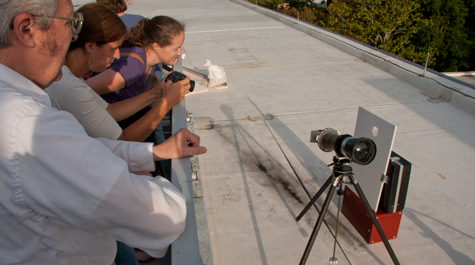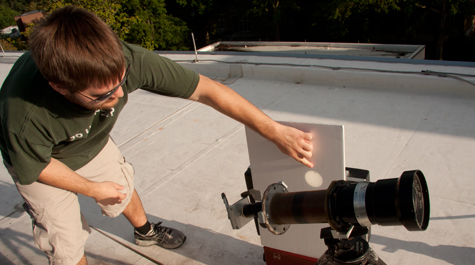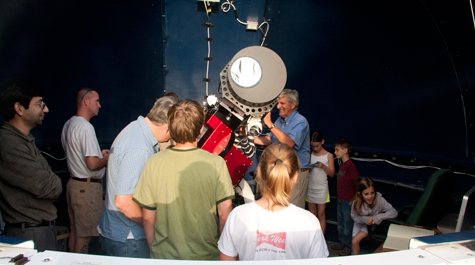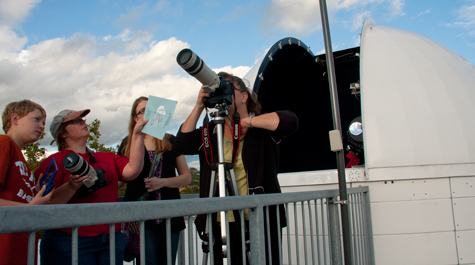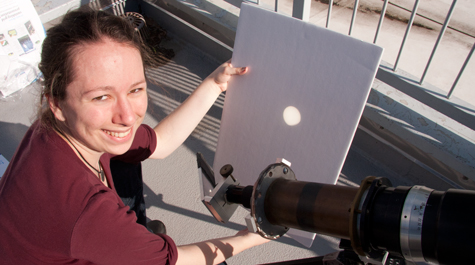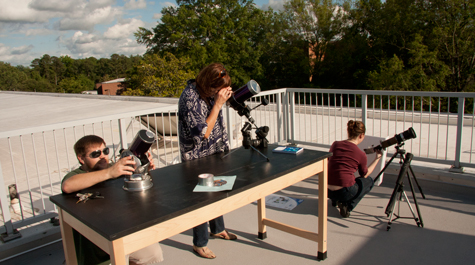Transit of Venus: Astronomers atop Small Hall get a break from the clouds
Cheerful optimism dueled with philosophical resignation atop Small Hall as moving clouds alternately obscured and revealed the setting sun.
A small group of Ph.D. students in physics set up viewing apparatus. Ellie Radue and Matt Simons aimed and focused two small Questar telescopes fitted with sun filters, plus another unfiltered telescope rigged to project an image on a sheet of white foam core. Megan Ivory set up a collation of Oreos, chips and pretzels for the guests.
Shortly before six p.m., observatory director Bob Vold arrived on the roof to open up the dome and get its 14-inch refractor telescope ready. Everyone kept commenting on the clouds, the gaps in the clouds and the wind.
The College of William & Mary was ready for the transit of Venus, if only the clouds would play nice.
The transit of Venus is the passage of the planet across the face of the sun, as visible from Earth. Transits come in pairs, eight years apart, and the pairs occur more than a hundred years apart. After June 6, 2012, the next transit of Venus will occur in 2117.
Venus crosses the face of the sun no matter what the clouds on earth are doing, but you can’t see it happen if the sun is covered by clouds. As guests to the Small Hall transit party began arriving, many remarked about being disappointed by cloud cover for the last transit in 2004.
“If we don’t get a break in the clouds, we have the live feed on the monitor in the lobby,” Simons told the gathering transit hunters.
As the time approached for first contact, the point at which the edge of Venus starts to become visible, the clouds moved over the sun. People passed the time by snacking on chips and pretzels and discussing the historical importance of the transit. The transits of the 17th and 18th centuries were particularly important, as scientists journeyed all over the globe to collaborate on calculating the distance from the earth to the sun.
“In order to get the distance from the earth to the sun, you have to very accurately time when Venus starts crossing the sun, and when it finishes crossing the sun from widely different spots on earth,” Vold explained in the days leading up to the transit. “If you have those times and you know the distance between the points, you can work out the average distance from the earth to the sun.”
One guest for the transit viewing, a history professor at Thomas Nelson Community College, told people about Thomas Jefferson’s extensive preparations to view the 1769 transit. Like many a transit hopeful throughout history, Jefferson was disappointed by clouds.
Shortly after 6 p.m., the sun came out and the transit watchers scrambled. Vold leaned out of the observatory shutter: “O.K., I can take about five or six people at a time.” Radue, Simons and Ivory repositioned their scopes and called people over to see Venus, which appeared as a small black circle near the edge of the sun.
One side of the roof was occupied by photographers, using both tripods and hand-held cameras to record the celestial event. Those who didn’t have purpose-made photographic filters passed around a mylar sheet to hold over their lens. The projection telescope was popular, especially among the young viewers, many of whom had trouble seeing the image in one of the Questar scopes. The projection image, once in focus, showed not only Venus, but also was sharp enough to show sunspots.
“See? Do you see that little dot?,” a mother asked her little daughter. “That’s Venus, going across the sun. Now remember that, because this won’t happen again until you’re, ah…a hundred and ten.”
Clouds kept moving across the sun, making for an interrupted viewing of the transit. Each time the clouds parted, Vold called another group into the observatory, the cameras came out and people gathered around the telescopes.
Radue, Simons and Ivory repositioned the small scopes to account for the setting sun. At one point, the Questars couldn’t be brought to bear, as the sun sank behind a portion of Small Hall. Simons took the projection scope out beyond the fenced area of the roof to extend the viewing time.
Sporadic clouds and sunset allowed for a total of around 20 minutes of good, clear viewing of the transit, but everyone was satisfied. Vold pronounced it a rousing success. He said that photographers got some very dramatic photos of the transit, as shots with partial cloud cover added context.
“Now, everyone come back here for the next transit,” Radue called to some departing guests. “We’re going to have a reunion in 2117!”















